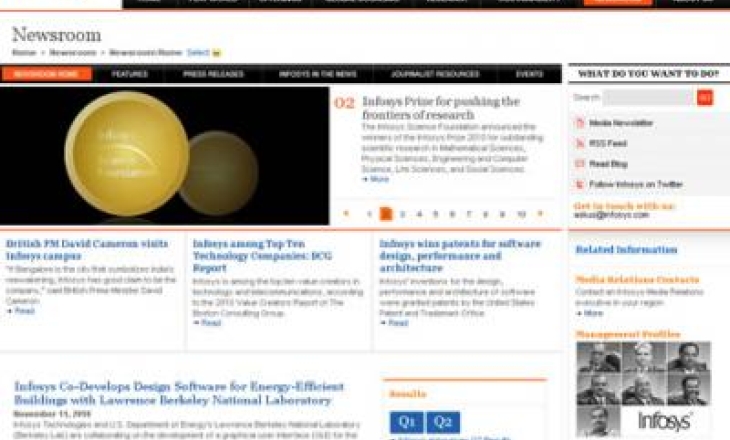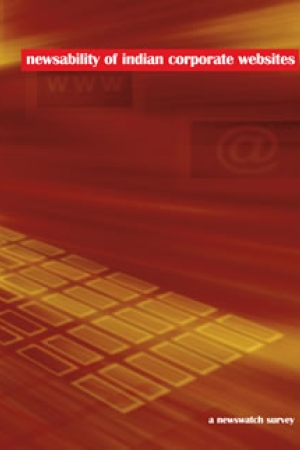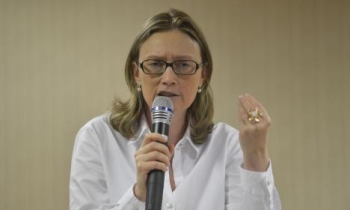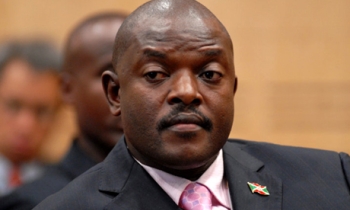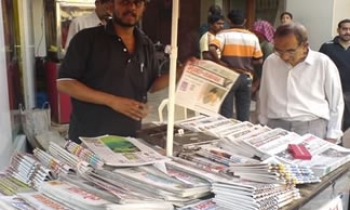The website of Infosys Technologies has been ranked the most Press-friendly in India. The ranking was done at the end of a study which identified gaps in Indian corporate websites that do not allow for a productive interaction between companies and journalists.
The Newsability of Indian Corporate Websites, released by Newswatch on Thursday, ranked 100 websites of Indian companies based on the findings. Tata, Dabur India Limited, Dr Reddy's Laboratories Limited and Aditya Birla Group came next in the rankings.
The Newswatch study identified over 50 gaps in Indian corporate websites based on over 100 parameters that were drawn up after interactions about their usability with 25 journalists. The journalists came from business newspapers, business section of general newspapers, business magazines, business section of general interest magazines, and niche B2B magazines. All offered their time as volunteers.
"Indian corporate websites are woefully incomplete when it comes to providing various kinds of information and tools that are sought by journalists," said Subir Ghosh, founder-editor of Newswatch. "The objective of this study was not to rank corporate websites, but to identify gaps that when filled up would go a long way in making life easier for journalists."
Newswatch India (www.newswatch.in) is an online entity which documents and monitors trends and news pertaining to the news media and journalism profession, both in India and at an international level. Newswatch now focuses primarily on news content analyses. Its recent study Undermined, which looked at how the news media covered the Vedanta / Niyamgiri issue, had been widely appreciated.
The Newswatch study does not look at either the quality or volume of content of corporate websites. Ghosh remarked, "That was not our mandate. What we needed to find out was whether Indian corporates, which spend a considerable amount of money on their websites, are able to leverage those sites for media coverage. What we surprisingly found was that most companies had no clue as to how to go about it. Our study identifies over 50 elements that can help corporates make better use of their sites for media coverage."
Top-ranked Infosys Technologies scored 70 in the points tally on a scale of 100. Tata (59.09), Dabur India Limited (55.45), Dr Reddy’s Laboratories Ltd (50.00) and Aditya Birla Group (47.27) fared relatively well. But most others failed to reach a particular standard. Sixtythree corporate websites scored 25 or less. Twentyfive companies scored 10 or less. Nine scored zero.
If your company has not been ranked in this study, it makes no difference. You can still use the findings to see where your company website stands in terms of being journalist-friendly. You can subsequently make necessary modifications. The report includes a do-it-yourself evaluation sheet.
Any study of this kind can be looked at as priceless feedback from users, in this case from journalists. That is because the parameters for judging the sites have not been determined by the publisher, but have been drawn from experiences of journalists who use corporate websites for a number of reasons.
This report is useful for:
- All Senior Management executives who are not experts in web technology, corporate communications or public relations; but need to know what's going on with their organisation's website;
- All Corporate Communications professionals of a company responsible for dealing with the media;
- All Public Relations professionals who handle the media for corporate clients and advise them on various media-related issues;
- All IT professionals responsible for designing a corporate website (which ideally would include a Press section).
A journalist colleague with a New Delhi-based business magazine was, some time back, in urgent need for some information on a company he was writing about. He visited the company’s website, but it didn’t help. There were no contact details available on the site either, because of which he could not get in touch with the company. As a result he ended up with a sketchily-written article. Officials at company, for their part, came across the article and were naturally a bit displeased with it. One of them contacted the journalist concerned to speak his mind out, but had to beat a retreat. The reporter let the executive know, in no uncertain terms, what he thought about the website and, indeed how professionally useless it was for him.
This journalist and I happened to exchange notes on the subject, and during those discussions the idea for this study was born.
Objective: The idea had been born more out of exigency rather than any expediency. For there were other journalists too who spoke of similar issues. Most would fall back on corporate websites in case of an emergency for information, and quite often graphics, but would end up disgusted.
A survey needed to be done, gaps in corporate websites needed to be identified. And one would come up with rankings. But these rankings were not to be the main objective; those would only be used to test the guidelines one came up with. This survey identifies over 50 gaps in the Press sections of Indian corporate websites, through over 100 parameters. It is now up to companies to fill the gaps. They stand nothing to lose, and every bit of mileage to gain.
Methodology: The parameters were identified by the usage experiences of 25 journalists with varied backgrounds. The journalists came from business newspapers, business section of general newspapers, business magazines, business section of general interest magazines, and niche B2B magazines.
Hundred corporate websites were tested on basis of the parameters that were drawn up. The companies selected for the survey had little in common except that those were randomly drawn from various company rankings that are published by various Indian magazines and newspapers.
The Newsability of Indian Corporate Websites report is a tautly compiled document on how a corporate entity can beef up its website so as to maximise its press coverage. Some highlights:
- The ZIP file (available for download) also contains the Excel sheet used to rank the 100 Indian corporate websites.
- There is a do-it-yourself checklist in the actual report which you can use to evaluate your website.
- The report tells you what journalists want, and what they find as irritants.
- The document contains close to 80 screenshots from websites which serve as illustrations for what works and what does not.
- The study is based on user experiences of journalists.
- You can download the report from our secure store on Plimus, by following this link:
https://www.plimus.com/jsp/buynow.jsp?contractId=2901248 - Alternatively, you can pay us through Paypal. We will send you an invoice with a payment link and relevant instructions. After the payment is done, we will email the document to you.
- You can also deposit the requisite amount directly into our bank account. The account details are available on specific request.
If you need clarifications, please email us at editor@newswatch.in. Please ensure that you email us from your official company ID.
- Infosys Technologies Ltd
- Tata
- Dabur India Limited
- Dr Reddy's Laboratories Ltd
- Aditya Birla Group
- Raymond India
- NIIT Limited
- Biocon
- Mahindra
- Wipro Technologies
- Thermax Limited
- GlaxoSmithKline Pharmaceuticals Ltd
- Ranbaxy
- HDFC Bank
- Essar Group
- Wockhardt
- Hindustan Unilever Limited
- Jet Airways
- ABB
- GAIL
- Shoppers Stop
- Hindustan Construction Company
- Canon India
- Godrej
- Sterlite Industries (I) Ltd
- Hyundai Motor Company
- Larsen & Toubro
- DLF
- Ashok Leyland
- Havells
- ITC
- Jindal Steel and Power
- Himalaya Herbal Healthcare
- Religare Enterprises Limited
- Max India
- Zee Entertainment Enterprises Limited
- Vodafone
- Cadbury India Limited
- Videocon Industries Ltd
- Kotak
- Philips India
- Bharat Sanchar Nigam Ltd
- Maruti Suzuki India Limited
- Bajaj Auto
- AC Nielsen
- Bharti Enterprises
- Royal Sundaram
- Whirlpool India
- Unitech Limited
- TVS Motor Company
- Samsung India
- Air India
- Hindware
- Hero Honda Motors Ltd
- Sun Pharmaceutical Industries Limited
- Oberoi Hotels & Resorts
- NTPC Ltd
- Asahi India
- MakeMyTrip Limited
- Eveready Industries
- Ambuja Cements Ltd
- Pidilite Industries Limited
- Indian Oil Corporation
- Kingfisher Airlines
- Sahara India Pariwar
- Reliance Industries Limited
- Lewis Berger Paints
- Toyota India
- Marico
- Hindustan Copper Limited
- Apollo Hospitals
- ICICI Bank
- Eureka Forbes
- Life Insurance Corporation of India
- Steel Authority of India Ltd
- Adani Group
- Godfrey Phillips India Ltd
- Housing Development & Infrastructure Ltd
- HCL Infosystems Ltd
- Reckitt Benckiser
- Bombay Dyeing
- Nestle India
- GMR Group
- Future Group
- Blue Dart
- Jaypee Group
- Usha Martin
- Vishal Retail Limited
- Camlin Limited
- IDBI Bank Ltd
- Reliance ADAG
- DCM Shriram
- Balmer Lawrie & Co Ltd
- MRF
- Goodricke
- Alembic Limited
- Kirloskar Brothers Limited
- Arvind Limited
- Colgate-Palmolive (India)
- P&G Hygiene and Health Care Limited

